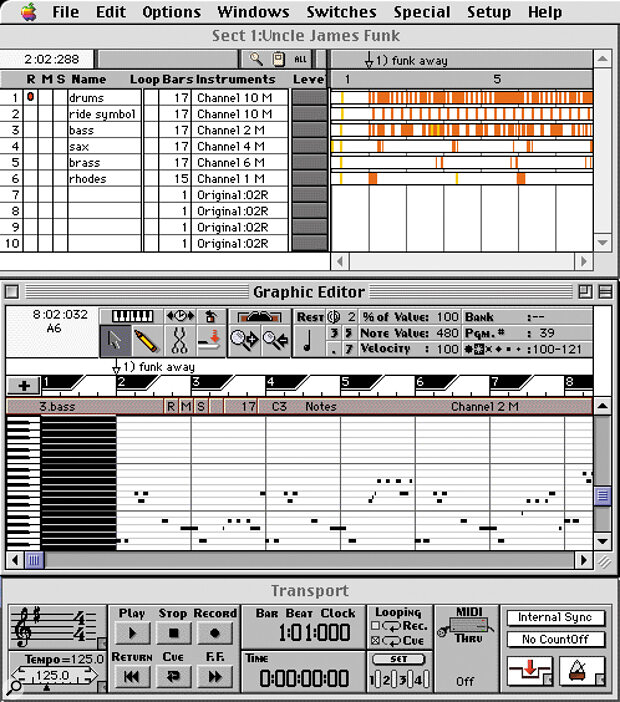-
Posts
1,325 -
Joined
-
Last visited
-
Days Won
2
Everything posted by Amberwolf
-
Might've missed it but didn't see Metro anywhere in the thread. Their first Mac offering, though I guess it didn't last long. Only quick screenshot I could find in an image search, dunno what version it is:
-

Audio stretch automatically when tempo changes?
Amberwolf replied to ot ouss's topic in Cakewalk Sonar
I don't know how the modern versions do it, but it's not in AS in the old ones, it's in the clip properties dialog, by doubleclicking on the clip or right clicking it and selecting properties or using Alt-Enter while the clip is selected. It would certainly be handy if *all* clip properties could be accessed from a non-modal floating window like the AS bar; if they've finally done that it'd be great, but it doesn't sound like it has happened yet. -
Unfortunately, unless you can edit the ADSR envelopes or the actual samples being played back to suit the style of playing, the only other ways are fairly complicated. The actual sound created by strings played one way is different than another way, so unless the sample is actually of that type of playing, it won't sound "right" to anyone that knows the difference. To the average ear it doesn't usually matter very much if it's "close". If you can recorded clips existing notes that sound the way you want, you can simply play those back at the appropriate times. If they aren't the right actual note / key, you can use the pitch up/down function within Sonar's clip properties to retune things at least a couple of semitones without undue artifacts in many cases. Another way: If you're stuck with the sounds you have, then if the synths are capable of MIDI CC control of volume, sustain, etc., you can use multiple channels of the synth to all play the same patch, and play just one note on each channel for however many overlapping or very close to overlapping notes there are. Start the playback of the notes before the part you want to hear, if the attacks are too slow, so that the part you want is at the time you want to hear it. Then use the CCs to turn the entire channel volume off until that part of the note comes in, and then turn it back off when you want it to stop. You're just using the volume control of the channel as an ADSR envelope. Some synths have other CCs they respond to for performance data, though each patch can vary in how or whether it does anything. You'd have to either experiment or check the MIDI implentation chart for that synth to find out. You can use the same method (or clip fades) to record audio samples of the sounds you want from your own synths. Or just edit the clip down to just the part you're after, with either clip gain envelopes or clip fades or both to be the ADSR envelope. If the computer is capable of it, you can get free soft synths (VST, etc) if you don't already have them that can playback samples. Then you can either find free samples that are of the type of note you want, or record some parts of the ones you already have and, instead of the in-track methods described above, you can put the samples into the player and play them with midi notes (after you've created the proper ADSR envelopes, velocity response, etc for them to sound as you wish). You can also check out the BBC Symphony Orchestra Discover synth page and contact them to see if you qualify for a free copy. It probably has the kind of sound you're after if your computer can run it in addition to Sonar.
-

Audio stretch automatically when tempo changes?
Amberwolf replied to ot ouss's topic in Cakewalk Sonar
At least in my ancient SONAR, if you have an audio clip set to "stretch to project tempo", it will do so. That's what I did for the wolf-sounds and other environmental sounds within my Wolf's Dream Of The Hunt track. however, if you have done any editing (slip editing, etc) to a clip *before* turning this on, at least in my version, it may do unexpected / undesirable things, so you should first bounce any edited clip and *then* enable that, if you experience issues just enabling it on an edited clip. (these isseus were probably fixed in modern versions, so you probably don't have to worry) -
Part of how you create these short, often-overlapping sounds depends on how the synth you are using actually works, and how it plays a specific note, how it's legato works (if it has that function), how it retriggers notes, how it handles note on vs note off, etc. Some synths do these things in realistic ways, and some don't. Some actually have specific samples you must trigger to get the effect you want, and some have specific ways of sending the data to get the result. When i poke around over at VI-Control forums (where quite a few orchestral composers post tips and tricks) I didn't find any general ways of doing it; it seems to be dependent on the synth or sample library being used.
-
If it matters, the legacy site apparently doesn't properly support https, so even though a browser tries to use it there, functions the browser requires for security (probably anything other than simple text) don't seem to work. But if you force the browser to use http, not https, everything appears to correctly work (that I've tried so far). In chrome there's a section in privacy and security you can turn off that may help (i thought there was a place to whitelist just certain sites for this but can't find it) "Advanced Always use secure connections Upgrade navigations to HTTPS and warn you before loading sites that don't support it" EDIT: This trick doesn't appear to work for download file links, but it does work for images.
-
Oh, and Patty Gurdy with her 18 string...
-
The HG was used by Bear McCreary in Battlestar Galactica in a few places. Here's him talking about why he chose that instrument for some bits I have an old EastWest world sounds demo package of CDs that includes an HG (for Gigasampler, I think), and instructions on how to use the drone and notes to recreate teh sound. I still want to make a piece featuring it, but haven't found the right one yet. Now that I have a bunch of good vocalization and orchestral bits to fill it out, I might be able to do so, though probably not soon.
-
Yes, resistance is fusile.
-
Not having watched the video, just seeing the screenshot in your post, it reminds me of the ancient Cakewalk FX3 Soundstage. (I actually had that one came in a box and everything, I think, before the housefire).
-
Those old cords (especially the ones that actually had to have their individual wires screwed into the phone and the receiver, rather than the clear cubic plugs later used) were really tough. I used some of them for my trailer lighting on early cargo bikes. (later I used AT-style (5-pin DIN like MIDI) keyboard cables off of old IBM keyboards (the ones built so tough you could use them to chop down trees if you had patience...then snap the keycaps back on and type up your experiences).
-
I bet it still sounds better than my "upgraded" FirstAct "guitar"....
-
Slight resemblance to a Hurdy Gurdy....
-

Problems with delay per articulation feature.
Amberwolf replied to Nigel Simmons's topic in Cakewalk Sonar
If that's on the legacy.cakewalk.com site, you'll need to force your browser to view the pages as http, not https. Don't know why that works, but it does. -
AFAIK only Next (of the Bandlab CW products) would work natively on a non windows machine. You might be able to get Sonar to run in a virtual machine; don't know how that will work out for audio/midi drivers / etc.
-

Cakewalk Command Center not connected anymore?
Amberwolf replied to Mad Musicologist's topic in Cakewalk by BandLab
EDIT: meant this to be a report on the post quited below, not a post in the thread. 😊 Sequioa is a mac OS version; I would guess this is some AI spambot that hasn't come back to add their spam yet. -
Not knowing which specific things you're referring to...If they're "rehashing" the same things, maybe that's because they are issues that need to be corrected? As a general rule, you don't get multiple people asking for or speaking against the same specific things, especially taking the time to keep restating it at every opportunity, unless they are a problem for those people. And in general, only a few percent (at most, usually many less) of any particular group of poeple will speak up about something, so there are likely many times the vocal amount of people that want (or don't want) whatever it is that's being spoken about. Please remember: Just because something (whatever it is) isn't a problem for one subset of people, doesn't negate the problem for all those that it does affect.
-

Is Sonar Free Tier limited only for a month?
Amberwolf replied to Tomoko Mikami's topic in Cakewalk Sonar
That sounds much easier for the average user to understand. -

Is Sonar Free Tier limited only for a month?
Amberwolf replied to Tomoko Mikami's topic in Cakewalk Sonar
No need to apologize--it wasnt' directed at anyone, it is simply a fact that this kind of question is going to be asked dozens, probalby hundreds or thousands of times. Also, there will be even more people that don't ask because they do find the answer in an existing thread, but shouldn't have had to come find it because the software itself should have clarified it for them in it's own message. I'd like to help prevent the wasting of time of support / dev personnel on it, when there are many more important things they could be doing. (FWIW, if a common message to a user of any device, software, etc., requires clarification, it is a poor message--even if it is accurate, if it is not complete it is insufficient and should be replaced with one that does not. You wouldn't want a traffic sign that makes STOP unclear, for instance.... -
FWIW, I'd rather have it err on the side of caution and keep unnecessary data than ever remove any files I might want to keep for any reason.
-

Is Sonar Free Tier limited only for a month?
Amberwolf replied to Tomoko Mikami's topic in Cakewalk Sonar
Perhaps the notification within the software could be clarified to explain this to users so you and any support personnel at bandlab don't have to keep answering this over and over and over and over and over..... -
Guess they didn't invite the bidet, plunger, or thermometer to the discussion.
-
If it was unpainted, did they preserve the aged patina in the final finish? That would be beautiful....there were various old structures (some of which used to be houses, some sheds, some barns, some wellhouses, etc) in the farm country I lived in as a kid in north texas, and I always loved the way that old old wood looked and felt.
-




